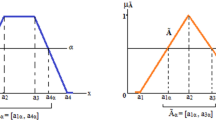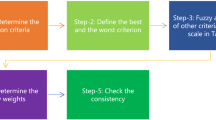Abstract
In this paper, we consider the problem of evaluating system characteristics (MTTF, reliability) using Markov modeling approach, in which times to failure and times to repair of the operating units are, assumed to follow fuzzified exponential distribution. A method has been developed to construct a fuzzy set as an estimator for unknown parameters in the proposed statistical model. Using the α-cut approach the fuzzy repairable system is extracted from the conventional crisp intervals for the desired system characteristics, which are determined with a set of parametric nonlinear programs using their membership functions. With the proposed approach, explicit closed-form expressions of the system characteristics are obtained by inverting the interval limits of α-cuts of membership functions.







Similar content being viewed by others
References
Cai, K.Y., Wen, C.Y., Zhang, M.L.: Fuzzy reliability modeling of gracefully degradable computing systems. Reliab. Eng. Syst. Saf. 33(1), 141–157 (1991)
Wang K. H., Chiu L.W.: Cost benefit analysis of availability systems with warm standby units and imperfect coverage. Applied mathematics and Computation. Vol. 172, 1239-1256
Pham, H.: Reliability analysis of a high voltage system with dependent failures and imperfect coverage. Reliab. Eng. Syst. Saf. 37, 25–28 (1992)
Akhtar, S.: Reliability of K-out-of-n: G system with imperfect fault coverage. IEEE Trans. Reliab. 43, 101–106 (1994)
Moustafa, M.: Reliability analysis of K-out-of-N:G systems with dependent failures and imperfect coverage. Reliab. Eng. Syst. Saf. 58, 15–17 (1997)
Trivedi, K.S.: Probability and statistics with reliability, queuing and computer science applications. Wiley, New York (2002)
Ke, J.C., Lee, S.L., Hsu, Y.L.: On a repairable system with detection, imperfect coverage and reboot: Bayesian approach. Simul. Model. Pract. Theory 16, 353–367 (2008)
Kruse, R., Schwecke, E., Heinsohn, J.: Uncertainty and vagueness in knowledge based systems. Springer, Heidelberg (1991)
Coit, D.: System-reliability confidence-intervals for complex-systems with estimated component-reliability. IEEE Trans. Reliab. 46(4), 487 (1997)
Leuschen M.L.: Through Fuzzy Markov Models. Master’s thesis. Rice University, Houston, TX, ECE Dept (1997)
Cai, K.Y., Wen, C.Y., Zhan, M.L.: Fuzzy variables as a basis for a theory of fuzzy reliability in the possibility context. Fuzzy Sets Syst. 42, 145–172 (1991)
Utkin, L.V.: Knowledge based fuzzy reliability assessment. Microelectron. Reliab. 34, 863–874 (1994)
Utkin, L.V.: Fuzzy reliability of repairable systems in the possibility context. Microelectron. Reliab. 34, 1865–1876 (1994)
Ke, J.C., Huang, H., Lin, C.H.: Redundant repairable system with imperfect coverage and fuzzy parameters. Appl. Math. Model. 32, 2839–2850 (2008)
Wang, S., Watada, J.: Reliability optimization of a series parallel system with fuzzy random lifetimes. Int. J. Innov. Comput. Inf. Control 5(6), 1547–1558 (2009)
Wang, Z., Huang, H.Z., Du, L.: Reliability analysis on competitive failure processes under fuzzy degradation data. Appl. Soft Comput. 11(3), 2964–2973 (2011)
Huang, H.I., Lin, C.H., Ke, J.C.: Parametric nonlinear programming approach for a repairable system with switching failure and fuzzy parameters. Appl. Math. Comput. 183, 508–517 (2006)
Klir, G.J., Yuan, B.: Fuzzy Set and Fuzzy Logic Theory and Applications. Prentice-Hall of India, New-Delhi (2005)
Ke, J.C., Huang, H.I., Lin, C.H.: Parametric Programming approach for a two-unit repairable system with imperfect coverage, reboot and fuzzy parameters. IEEE Trans. Reliab. 57, 498–506 (2008)
Kao, C., Li, C.C., Chen, S.P.: Parametric programming to the analysis of fuzzy queues. Fuzzy Sets Syst. 107, 93–100 (1999)
Chen, S.P.: Parametric nonlinear programming for analyzing fuzzy queues with finite capacity. Eur. J. Oper. Res. 157, 429–438 (2004)
Chen, S.P.: Parametric nonlinear programming approach to fuzzy queues with bulk service. Eur. J. Oper. Res. 163, 434–444 (2004)
Billinton R., Bollinger K.E.: Transmission System Reliability Evaluation Using Markov Processes. IEEE Transactions on Power Apparatus and Systems. Vol. 87, No. 2 (1968)
Bouricius W. C., Carter W. C., Schneider P. R.: Reliability modeling techniques for self-repairing computer systems. In Proceedings of 24th Annual ACM National Conference. pp. 295–309 (1969)
Arnold, T.F.: The concept of coverage and its effect on the reliability model of a repairable system. IEEE Trans. Comput. C-22, 251–254 (1973)
Zadeh, L.A.: Fuzzy sets as a basis for a theory of possibility. Fuzzy Sets Syst. 1, 3–28 (1973)
Kaufmann, A.: Introduction to the theory of fuzzy subsets, 1st edn. Academic, New York (1975)
Zimmermann H. J.: Fuzzy Set Theory and Its Application, 4th ed. Boston Kluwer Academic (2001)
Yager, R.R.: A procedure for ordering fuzzy subsets of the unit interval. Inf. Sci. 24, 143–161 (1981)
Fortemps, P., Roubens, M.: Ranking and defuzzification methods based on area compensation. Fuzzy Sets Syst. 82, 319–330 (1996)
Author information
Authors and Affiliations
Corresponding author
Appendices
Appendix 1. The Laplace transform equations fo a reliability model of a two-unit repairabel system
Assume that the process initially is in state 2, so P2(0) = 1, P1(0) = 0 and P0(0) = 0. For the state transition diagram given in Fig. 1, the system differential equations using Laplace transforms are obtained in terms of λ, μ, and coverage-factor c are given by
On solving this system of linear equations we obtain the Laplace transforms of Pi(t) for i = 0, 1, 2.
Appendix 2. The steady-state equations of an availability model for a two-unit repairabel system
From the state transition diagram given in Figs. 2 and 3 the steady-state equations of the process are given by
On solving this system of linear equations the steady-state probabilities can be obtained as:
Rights and permissions
About this article
Cite this article
Uprety, I., Patrai, K. Estimating reliability of a repairable system with imperfect coverage and fuzzy parameters using parametric non-linear programming approach. OPSEARCH 53, 1–15 (2016). https://doi.org/10.1007/s12597-015-0216-7
Accepted:
Published:
Issue Date:
DOI: https://doi.org/10.1007/s12597-015-0216-7




